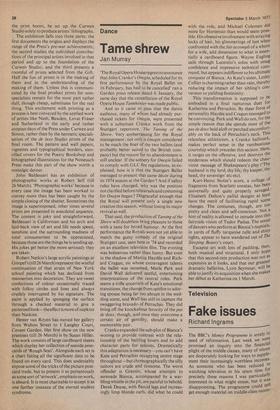Dance
Tame shrew
Jan Murray The Royal Opera House regrets to announce that John Cranko's Onegin, scheduled for its first performance by the Royal Ballet on 16 February, has had to be cancelled' ran a Garden press release dated 6 January, the same day that the cancellation of the Royal Opera House Tannhiiuser was made public.
And so it came to pass that the dance audience, many of whom had already purchased tickets for Onegin, were presented with a substitute Cranko work from the Stuttgart repertoire, The Taming of the Shrew. Very embarrassing for the Royal management : not only is Onegin considered to be much the finer of the two ballets (and probably better suited to the British company) but the reason for its abandonment is still unclear. If the scenery for Onegin failed to comply with G LC fire regulations, as explained, how is it that the Stuttgart Ballet managed to present that same decor during its 1974 season at the Garden ? And if safety rules have changed, why was the position not clarified before rehearsals and costuming for Onegin began ? Disgraceful enough that the Royal will present only a single new creation this season, without losing its major revival as well.
That said, the production of Taming of the Shrew will doubtless bring pleasure to those with a taste for broad humour. At the first performance the Royals were not yet able to match the gutsy comedy of the original Stuttgart cast, seen here in '74 and recorded on an excellent television film. The evening was boisterous rather than funny. But even in the shadow of Marcia Hayclee and Richard Cragun, on whose extravagant talents the ballet was mounted, Merle Park and David Wall delivered zestful, entertaining interpretations of the central roles. Park seems a trifle uncertain of Kate's emotional transitions, the change from spitfire to adoring spouse being far too abrupt in the wedding scene, and Wall has still to capture the swaggering bravado of PetructUo. They did bring off the knockabout ferocity of the pas de deux, though, and once they overcome a certain air of gentility, should make a memorable pair.
Cranko expanded the sub-plot of Bianca's wooing to provide contrast with the relationship of the battling lovers and to add character parts for soloists. Dramatically this adaptation is necessary—you can't have Kate and Petruchio occupying centre stage throughout—but choreographically the silly suitors are crude and tiresome. The worst offender is Gremio, whose attempts to serenade Bianca, accompanied by a warbling whistle in the pit, are painful to behold. Derek Deane, with flaccid legs and increasingly limp blonde curls, did what he could
with the role, and Michael Coleman did more for Hortensio than would seem possible. His obsessive involvement with straying locks of hair, his glimmerings of lust when confronted with the fait accompli of a whore for a wife, add dimension to what is essentially a cardboard figure. Wayne Eagling sails through Lucentio's solos with smug confidence and impressive technical command, but appears indifferent to his ultimate conquest of Bianca. As Kate's sister, Lesley Collier is charming rather than vain, therebY reducing the impact of her sibling's conversion to yielding femininity. This transformation is supposed to be embodied in a final rapturous duet for Katherina and Petruchio. By sheer force of personality Haydee and Cragun managed to be convincing. Park and Wall do not, for the simple reason that she spends most of the pas de deux held aloft or perched uncomfortably on the back of Petruchio's neck. This relentless athleticism, a Cranko hallmark, makes perfect sense in the rumbustious courtship which precedes this section; Here, it verges on the offensive, and destroys the tenderness which should redeem the chauvinist message of Shakespeare's play ('ThY husband is thy lord, thy life, thy keeper, thy head, thy sovereign' etc etc). Kurt-Heinz Stolze's score, a collage of fragments from Scarlatti sonatas, has been universally and quite properly savaged. Elisabeth Dalton's pallid designs at least have the merit of facilitating rapid scene changes. The costumes, though, are too pretty and clean and self-conscious. Not a hint of reality is allowed to intrude into this fairytale vision of Tudor Padua. The sextet of dancers who perform at Bianca's nuptials, in yards of fluffy turquoise tulle and shinY tights, appear to have wandered out of The Sleeping Beauty's court.
Escapist art with lots of padding, then, both musical and structural. I only hope that this second-rate production was not as expensive as it looks, and that our greatest dramatic ballerina, Lynn Seymour, will be able to justify its acquisition when she makes her debut as Katherina on 1 March.


































 Previous page
Previous page